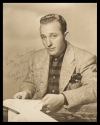During the Big Band Era, Georgetown University engaged a number of notable acts to entertain students at junior and senior “prom”enades, as reflected in articles on display in this exhibition, reproduced from University publications and The Washington Post. We also showcase selections from the Arthur Johnston Papers, held by the Library’s Special Collections Research Center. Johnston, an American songwriter, scored some of the best known films of Hollywood’s Golden Age and collaborated with many of the era’s greatest musicians, performers, and lyricists.
Paul Whiteman
Paul Whiteman (1890-1967) was the conductor of one of the most successful dance bands of the 1920s and was often referred to as the “King of Jazz.” In reality, Whiteman’s band performed a blend of “symphonic” music and jazz that catered to high society and leaned toward simple dance arrangements. Whiteman commissioned George Gershwin’s Rhapsody in Blue in 1924, billing the event as “An Experiment in Modern Music” in New York City’s Aeolian Hall.
The lead sheet presents the melody and instrumentation for the hit “Belle of New Orleans.” It was performed by the vocalist and pianist billed simply as “Ramona” (and often as “Ramona and Her Grand Piano”). Born Estrild Ramona Myers, Ramona was a friend and musical interpreter of Gershwin and ultimately joined Whiteman’s band in 1932. She had a long and international career, which concluded with her death in 1972.
From the Arthur Johnston Papers
Harry Lillis “Bing” Crosby
Harry Lillis “Bing” Crosby (1903-77) was among a group of singers that developed a style of relaxed, intimate singing in the 1920s and 1930s, eventually referred to as “Crooning.” Every big band of the decade, and thereafter, included vocalists to perform ballads and love songs in this style. Crosby had his first important breakthrough as a vocalist with the Paul Whiteman Orchestra and eventually had a long collaboration with the Carl Fenton Orchestra. Crosby was also among the first musicians to find success on the radio, and made important contributions to the development of the recording industry. As a singer, he is considered to be an important influence on many big band singers, especially Frank Sinatra.
From the Arthur Johnston Papers
Glenn Miller
Glenn Miller (1904-44) was among the most important and popular musicians of the big band era in America. A talented trombonist, he was also a gifted composer and arranger, whose ensemble reached its peak in the period 1939-1943. Miller’s big band produced a number of popular hits, including “In the Mood,” “Moonlight Serenade,” Tuxedo Junction,” and “Pennsylvania 6-5000.” Miller’s performance at the Senior Ball held at the Wardman Park Hotel, as noted in the advertisement, was undoubtedly one of the highlights of that year.
The Hoya, May 1, 1940
Isham Jones
Isham Jones (1894-1956) led one of the earliest bands to combine the improvisation of jazz with dance idioms in the 1920s. His recording of Wabash Blues in 1921 sold more than one million copies and his recordings for the Victor label (1932-35) were critically and commercially popular. A number of musicians who would go on to great acclaim performed with Jones’s band including Benny Goodman, Woody Herman and Bing Crosby, the last of whom made two recordings with the Jones band in a decidedly jazz style. Jones performed for the Junior Prom at Georgetown in 1935 and The Hoya notes that they were “undoubtedly the best band to play at a Georgetown Junior Prom for the last several years.”
The Hoya, January 16, 1935
Gene Krupa
Gene Krupa (1909-73) came to national prominence as the drummer for Benny Goodman’s big band in 1934. Krupa’s energetic and highly original style was highlighted on the Goodman recording of “Sing, Sing, Sing,” which features one of the first recorded drum solos. His appearance at Georgetown University in 1938 was as leader of his own ensemble for the annual Tea Dance. In an interview prior to the dance, Krupa claimed that he would “play sweet and hot as well as sweet and smooth.”
The Hoya, May 4 and May 11, 1938
The Washington Post, May 6, 1938
Artie Shaw
Although Georgetown had been successful for numerous years in securing the most prominent big bands, one artist made local headlines for his cancellation: Artie Shaw (1910-2004). The great clarinetist and rival to Benny Goodman had agreed to perform at The Diplomats Ball in 1950 and had even secured the required advance of 50%; however, the university cancelled the event due to the bandleader’s multiple marriages. The Washington Post notes Shaw’s compensation as $1,800 a night; equal in contemporary value to more than $17,000. All inquiries were referred to Fr. Edmund Walsh, founder of the School of Foreign Service.
The Washington Post, April 23, 1950
Artie Shaw
Although Georgetown had been successful for numerous years in securing the most prominent big bands, one artist made local headlines for his cancellation: Artie Shaw (1910-2004). The great clarinetist and rival to Benny Goodman had agreed to perform at The Diplomats Ball in 1950 and had even secured the required advance of 50%; however, the university cancelled the event due to the bandleader’s multiple marriages. The Washington Post notes Shaw’s compensation as $1,800 a night; equal in contemporary value to more than $17,000. All inquiries were referred to Fr. Edmund Walsh, founder of the School of Foreign Service.
The Washington Post, April 23, 1950
Curated by Anthony R. DelDonna.
Assisted by Lynn Conway, Ann Galloway, Stephanie Hughes and Scott Taylor.
Photography by David Hagen.
In conjunction with the Friday Music Series performance "Big Band Era," featuring Professor Aaron Broadus leading the Georgetown Jazz Ensemble, on Friday, September 20, 2013.











